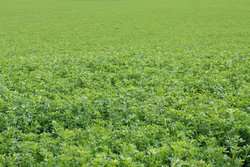Report was released August 31
By Diego Flammini
Assistant Editor, North American Content
Farms.com
OMAFRA’s Field Crop Team released its latest Field Crop Report, and fall forages were the central theme.
As with many crops throughout the province, the rains last week played an important role in field development.
“With the recent rains, many hay fields have seen significant growth in the last two weeks,” the Field Crop Team writes.
However, farmers now need to decide whether to take a fall cutting of alfalfa.

“This year, plants have been stressed from the dry weather and now we are contemplating stressing them further by taking a fall cutting,” the report says. “Even if there is no winterkill, the added stress typically results in the delay of first cut in the spring with yields reduced by roughly the same tonnage that would be harvested in the fall.”
Cutting alfalfa close to a killing frost can minimize the risk of winterkill.
If alfalfa is cut before a frost, there could be little regrowth to deplete nutrient reserves. If it’s cut after, the leaves can start to drop and nutrients will leach out of the plant.
According to the Field Crop Report, a killing frost for alfalfa occurs when the temperature reaches -4°C for several hours.